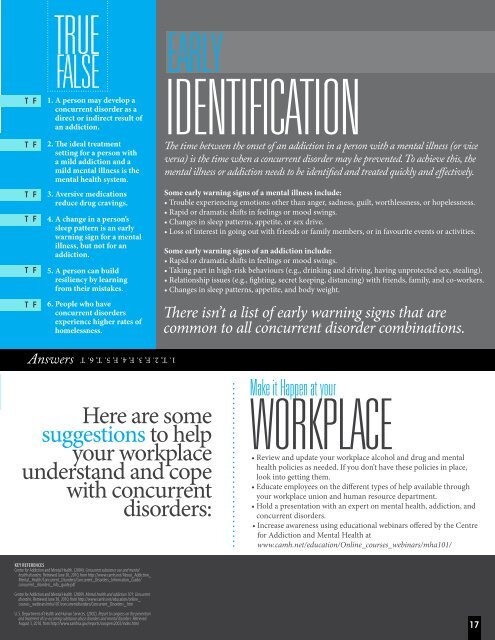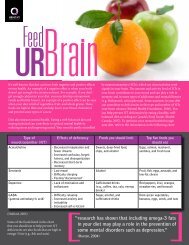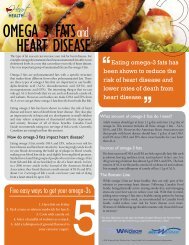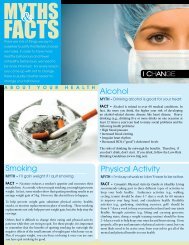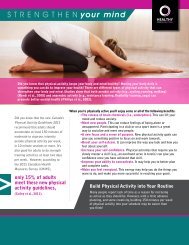Healthy Minds Matter Newsletter and Brochure (pdf)
Healthy Minds Matter Newsletter and Brochure (pdf)
Healthy Minds Matter Newsletter and Brochure (pdf)
You also want an ePaper? Increase the reach of your titles
YUMPU automatically turns print PDFs into web optimized ePapers that Google loves.
T FT FT FT FT FT FTRUEFALSE1. A person may develop aconcurrent disorder as adirect or indirect result ofan addiction.2. The ideal treatmentsetting for a person witha mild addiction <strong>and</strong> amild mental illness is themental health system.3. Aversive medicationsreduce drug cravings.4. A change in a person’ssleep pattern is an earlywarning sign for a mentalillness, but not for anaddiction.5. A person can buildresiliency by learningfrom their mistakes.6. People who haveconcurrent disordersexperience higher rates ofhomelessness.EarlyIDENTIFICATIONThe time between the onset of an addiction in a person with a mental illness (or viceversa) is the time when a concurrent disorder may be prevented. To achieve this, themental illness or addiction needs to be identified <strong>and</strong> treated quickly <strong>and</strong> effectively.Some early warning signs of a mental illness include:• Trouble experiencing emotions other than anger, sadness, guilt, worthlessness, or hopelessness.• Rapid or dramatic shifts in feelings or mood swings.• Changes in sleep patterns, appetite, or sex drive.• Loss of interest in going out with friends or family members, or in favourite events or activities.Some early warning signs of an addiction include:• Rapid or dramatic shifts in feelings or mood swings.• Taking part in high-risk behaviours (e.g., drinking <strong>and</strong> driving, having unprotected sex, stealing).• Relationship issues (e.g., fighting, secret keeping, distancing) with friends, family, <strong>and</strong> co-workers.• Changes in sleep patterns, appetite, <strong>and</strong> body weight.There isn’t a list of early warning signs that arecommon to all concurrent disorder combinations.Answers1. T, 2. F, 3. F, 4. F, 5. T, 6. THere are somesuggestions to helpyour workplaceunderst<strong>and</strong> <strong>and</strong> copewith concurrentdisorders:Key ReferencesCentre for Addiction <strong>and</strong> Mental Health. (2004). Concurrent substance use <strong>and</strong> mentalhealth disorders. Retrieved June 30, 2010, from http://www.camh.net/About_Addiction_Mental_Health/Concurrent_Disorders/Concurrent_Disorders_Information_Guide/concurrent_disorders_info_guide.<strong>pdf</strong>Centre for Addiction <strong>and</strong> Mental Health. (2009). Mental health <strong>and</strong> addiction 101: Concurrentdisorders. Retrieved June 30, 2010, from http://www.camh.net/education/online_courses_webinars/mha101/concurrentdisorders/Concurrent_Disorders_.htmU. S. Department of Health <strong>and</strong> Human Services. (2002). Report to congress on the prevention<strong>and</strong> treatment of co-occurring substance abuse disorders <strong>and</strong> mental disorders. RetrievedAugust 3, 2010, from http://www.samhsa.gov/reports/congress2002/index.htmlMake it Happen at yourWORKPLACE• Review <strong>and</strong> update your workplace alcohol <strong>and</strong> drug <strong>and</strong> mentalhealth policies as needed. If you don’t have these policies in place,look into getting them.• Educate employees on the different types of help available throughyour workplace union <strong>and</strong> human resource department.• Hold a presentation with an expert on mental health, addiction, <strong>and</strong>concurrent disorders.• Increase awareness using educational webinars offered by the Centrefor Addiction <strong>and</strong> Mental Health atwww.camh.net/education/Online_courses_webinars/mha101/17 9


